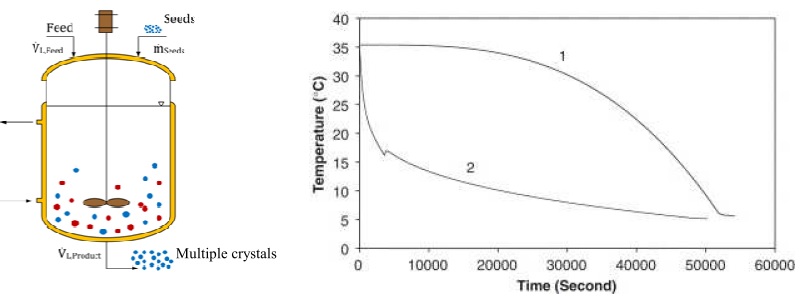1. Batch crystallization modeling and optimal control
Batch crystallization is one of the most important industrial separation and purification process.
Minimization of operation costs and the enhancement in product quality have been the major concerns for all industrial processes.
Predetermined operating conditions can help in achieving the goals for efficient production. These conditions can be determined using optimal control methods.
Optimal control problems are characterized by determination of time varying profiles for process parameters like temperature, supersaturation, etc.
Being a particulate process, crystallization is modeled in terms of population balance equations (PBE) which include kinetics of nucleation (new crystal formation)
and crystal growth. Since PBEs are multi-dimensional, their implementation in control functions is tedious and hence the model order reduction method,
known as ‘method of moments’ is employed in this research. Each moment signifies a characteristic of the crystal like zeroth moment corresponds to the number,
first to the size, third to the mass, etc. Thus, depending upon the desired characteristics of the final product the optimization objectives were formulated in terms of moments.
The temperature was selected as the control variable, while the process performance was determined by the crystal size distribution and product yield at the final time.
These problems can be solved by different methods such as calculus of variations, dynamic programming, discretized non-linear programming and maximum principle.
The maximum principle method was employed since it had computational advantages over its counterparts.
The method required proper mathematical representation of the problem and followed a well-defined iterative solution strategy.
The optimal temperature profile provided a narrower crystal size distribution with high probability density in the desired
size range in lesser time as compared to the simple linear temperature profile.

Figure 1. Batch crystallizer and operating temperature policies (1) and (2) for different final product quality
2. Uncertainties in crystallization and stochastic optimal control
Batch crystallization is associated with parameters such as temperature, supersaturation, initial condition, kinetic constants and agitation.
These process parameters can have various physical and engineering sources of uncertainties, which, in turn, would prevent the real process operation to be optimal.
These static uncertainties can sometime result into dynamic uncertainties, because of the unsteady state nature of the process.
The aim is to develop a novel approach to solve optimal control problems in batch crystallization involving uncertainties.
These uncertainties are modeled as a special class of stochastic processes called Ito processes.
The resulting stochastic optimal control problem is solved using Ito’s Lemma, stochastic calculus, and stochastic maximum principle.
The comparison between the results for the deterministic and the stochastic optimal temperature profile show that, when uncertainties are present,
the stochastic optimal control approach gives better results, in terms of maximum crystal growth, represented in terms of crystallization moments.
Improvements are observed in the final crystal size distribution and yield when the stochastic optimal temperature profile is used for process operation,
in comparison to the deterministic and linear cooling cases, in the presence of parametric uncertainty.

Figure 2.1. Temperature profiles (i) Linear - used in industries
(ii) Deterministic - optimal control result without uncertainty
(iii) Stochastic - optimal control result under uncertainty

Figure 2.2. (1) Particle size distribution using stochastic optimal (S) and linear temperature (L) profiles
(2) Particle size distribution using stochastic (S) and deterministic (D) optimal temperature profiles